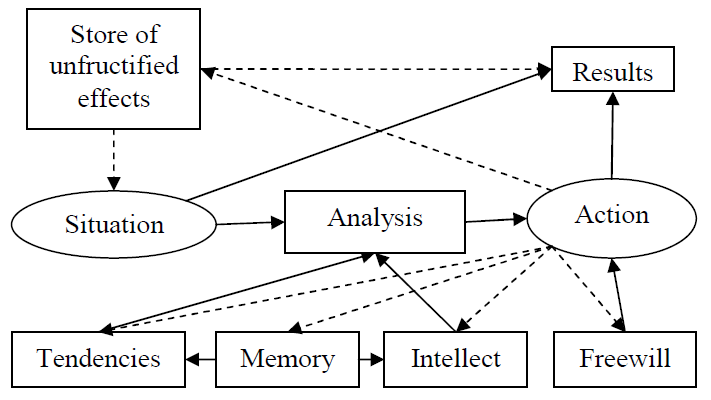Freewill is the foundation of all actions of man and the possibility of man to improve himself. Exercise of freewill is in the context of a cause-and-effect system in the world. Every result should be appropriate to the action causing it. Otherwise there can be no basis to exercise the freewill. Any given sitation in life is the result of the fructification of the effects of past actions. The situation is analyzed by the intellect as regards to what is right and what is wrong. Past tendencies try to influence the action by proposing what is desirable and what is not. Memory provides input about past similar situations, the action taken and the result attained. Using all these information, the person takes an independent decision on what to do in the current situation.
Any given sitation in life is the result of the fructification of the effects of past actions. The situation is analyzed by the intellect as regards to what is right and what is wrong. Past tendencies try to influence the action by proposing what is desirable and what is not. Memory provides input about past similar situations, the action taken and the result attained. Using all these information, the person takes an independent decision on what to do in the current situation.
The result is the effect of the situation, the action and the influence of the effects of the past actions. Not all the current action fructifies as the current result. A part of it is stored as unfructified effect, which will contribute towards future situations and results.
The individual is the holder of this store, freewill, tendencies, memory and intellect. He continues to exist and play this part across multiple lives. When the body dies, the individual takes on a new body (which is also a situation) and continues. The new body can be of a human being or an animal or a plant. The body can be strong or weak to be able to manifest the various faculties like memory, intellect and tendencies to various degrees.
The freewill becomes stronger if decisions are made more towards the way shown by the intellect as right than towards the way shown by the tendencies as desirable. This is the way to improvement of the individual.
Using this model, Hinduism answers most of the questions that arise about the world that we see like:
- Why do we see good people facing bad situations in life?
- Why are some children born in rich families and some in poor families?
- What will happen to me after death?
- When a person dies, what will happen to all the good and bad things done by a person?
- Why should we be good?
- What is wrong in cheating others and harming others?
This explains only the current link in the chain. Questions like “how did the whole process start?” are not answered by this model. However, this model is a good working model for all day-to-day activities.
The final goal, however, is to realize that one’s own individuality is only a relative one. To drop the individuality and thus to get out of this cycle is the ultimate goal of life. It need not be done immediately. As the person evolves by repeatedly choosing the “good” over the “desirable”, he becomes purer and purer. This can take several lifetimes.
At one point of the evolution, he becomes pure enough to start the quest on the real nature of himself. Then he gets the knowledge from the exposition of the scriptures by a teacher. By assimilating the knowledge, he becomes free.
